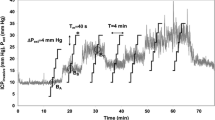Summary
A pressure transducer with a disposable, presterilized fluid chamber was developed to increase the safety margin when recording cerebrospinal fluid (CSF) pressure. With this system the fluid compartment is completely separated from the transducer proper, reducing electrical hazard and the risk of infection. The operational range is form — 20 mm Hg to 300 mm Hg with good static accuracy. The transducer with stopcocks has a flat frequency response of up to 75 Hz, showing that the two-part principle is compatible with good dynamic performance.
The transducer system was easy to handle and well suited to the recording of ventricular fluid pressure, detection of spinal subarachnoid block, the investigation of CSF absorptive capacity, as well as blood pressure recording. When the transducer was connected to standard disposable stopcocks, needles, and tubing as for these recordings, the dynamic accuracy of the whole apparatus was satisfactory for analysis of the pulsatile wave-form. A total of 185 CSF pressure recordings was performed without complication.
Similar content being viewed by others
References
Bergel, D. H., The measurement of lengths and dimensions. In: Cardiovascular fluid dynamics (Ed.: D. H. Bergel), Vol. I, p. 91–114. New York and London: Academic Press. 1972.
Burton, A. C., Methods of measuring blood flow. In: Peripheral circulation in man (Ciba Foundation Symposium), p. 3–22. Boston: Little. 1954.
Fry, D. L., Physiologic recording by modern instruments with particular reference to pressure recording. Physiol. Rev.40 (1960), 753–788.
Gilland, O., Cerebrospinal fluid dynamics in spinal subarachnoid block. Acta Neurol. Scand.38 (1962), 285–305.
—, CSF dynamic diagnosis of spinal block IV: Demands on electromanometric equipment. Acta Neurol. Scand.41 (1965), Suppl. 13, 75–104.
—, and J. R. Nelson, Lumbar cerebrospinal fluid electromanometrics with a minitransducer. Neurology20 (1970), 103–114.
Guillaume, J., and P. Janny, Manometrie intracranienne continue. Interet de la methode et premieres resultats. Rev. Neurol.84 (1951), 131–142.
Hilton, J. S., P. S. Lederer, and J. D. Sethian, A simple hydraulic sinusoidal pressure calibrator. Nat. Bur. Stand. (US), Techn. note 720, 1972.
Hussey, F., B. Schanzer, and R. Katzman, A simple constant-infusion manometric test for measurement of CSF absorption. II. Clinical studies. Neurology20 (1970), 665–680.
Johnston, D., and F. Serck-Hanssen, Frequency response of blood pressure transducer and simple catheter tube networks. Oslo: Central Institute for Industrial Research. 1971.
Katzman, R., and F. Hussey, A simple constant-infusion manometric test for measurement of CSF absorption. I. Rationale and method. Neurology20 (1970), 534–544.
Lakke, J. P. W. F., Queckenstedt's test. Amsterdam: Excerpta medica. 1969.
Langfitt, T. W., Increased intracranial pressure. Clinical Neurosurgery16 (1969), 436–471.
Leeming, M. N., Protection of the “Electrically susceptible patient”: A discussion of systems and methods. Anesthesiology38 (1973), 370–383.
Lundberg, N., Continuous recording and control of ventricular fluid pressure in neurosurgical practice. Acta Psychiat. Neurol. Scand.36 (1960), Suppl. 149, 1–193.
MacMillan, A. L., and F. D. Stott, Continuous intra-arterial blood pressure measurement. Bio. Med. Eng.3 (1972), 17–27.
Magnæs, B., and H. Nornes, Traumatic tension pneumo—hydrocephalus. The intracranial pressure pattern and the pathogenetic factors. Acta Neurochir.27 (1972), 17–27.
McCutcheon, E., J. M. Evans, and R. R. Stanifer, Direct blood-pressure measurement: Gadgets versus progress. Anesth. Analg.51 (1972), 746–756.
McDonald, D. A., Blood flow in arteries. London: Arnold. 1960.
Nelson, J. R., and S. J. Goodman, An evaluation of the cerebrospinal fluid infusion test for hydrocephalus. Neurology21 (1971), 1037–1053.
Nornes, H., Hemodynamic aspects in the management of carotidcavernous fistula. J. Neurosurg.37 (1972), 687–694.
—, Pressure transducer with disposable measuring head for ventricular fluid pressure monitoring. Paper presented at the 24th annual meeting of the Scandinavian Neurosurgical Society, Odense, 1972. Acta Neurol. Scand.49 (1973), 252.
—, and T. Hauge, Longtime intracranial epidural pressure recording in man. Acta Neurol. Scand.45 (1969), 240.
—, and B. Magnæs, Supratentorial epidural pressure recorded during posterior fossa surgery. J. Neurosurg.35 (1971), 541–549.
——, Intracranial pressure in patients with ruptured saccular aneurysm. J. Neurosurg.36 (1972), 537–547.
—, and F. Serck-Hanssen, Miniature transducer for intracranial pressure monitoring in man. Acta Neurol. Scand.46 (1970), 203–214.
Patel, D. J., D. T. Mason, and J. Ross, Jr., et al., Harmonic analysis of pressure pulses obtained from the heart and great vessels of man. Amer. Heart J.69 (1965), 785–794.
Shapiro, H. M., S. R. Wyte, and A. B. Harris et al., Disposable system for intraventricular pressure measurement and CSF drainage. Technical note. J. Neurosurg.36 (1972), 798–801.
Sundbärg, G., Å. Kjällquist, and N. Lundberg et al., Complications due to prolonged ventricular fluid pressure recording in clinical practice. In: Intracranial pressure (Eds.: Brock, M. and H. Dietz), p. 348–352. Berlin-Heidelberg-New York: Springer. 1973.
Author information
Authors and Affiliations
Rights and permissions
About this article
Cite this article
Nornes, H., Magnæs, B. Safety and accuracy in the clinical recording of cerebrospinal fluid pressure. Acta neurochir 29, 41–51 (1973). https://doi.org/10.1007/BF01414615
Issue Date:
DOI: https://doi.org/10.1007/BF01414615




